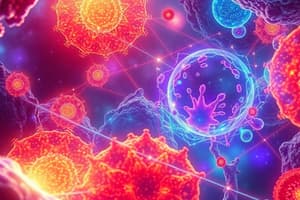Podcast
Questions and Answers
Who named the small compartments he observed in cork tissue 'cells', after their resemblance to rooms in monasteries?
Who named the small compartments he observed in cork tissue 'cells', after their resemblance to rooms in monasteries?
- Isaac Newton
- Robert Hooke (correct)
- Galileo Galilei
- Anton van Leeuwenhoek
Which scientist, known for creating his own microscopes, was the first to observe single-celled creatures like bacteria?
Which scientist, known for creating his own microscopes, was the first to observe single-celled creatures like bacteria?
- Louis Pasteur
- Gregor Mendel
- Robert Hooke
- Anton van Leeuwenhoek (correct)
What did Anton van Leeuwenhoek observe inside the blood samples he examined?
What did Anton van Leeuwenhoek observe inside the blood samples he examined?
- Plant cells
- Red and white corpuscles (correct)
- Virus particles
- Mitochondria
In what century did Robert Hooke observe cork tissue under magnification, leading to the naming of 'cells'?
In what century did Robert Hooke observe cork tissue under magnification, leading to the naming of 'cells'?
Which of the following scientists is associated with examining structures found within cells?
Which of the following scientists is associated with examining structures found within cells?
What contribution did Robert Hooke make to the study of cells?
What contribution did Robert Hooke make to the study of cells?
Who proposed the cellular hypothesis suggesting that every part of a cell is derived from pre-existing cells by division?
Who proposed the cellular hypothesis suggesting that every part of a cell is derived from pre-existing cells by division?
Which scientist emphasized the idea that each cell can perform its specific functions without relying on other body parts for survival?
Which scientist emphasized the idea that each cell can perform its specific functions without relying on other body parts for survival?
What is the concept that states all living organisms are composed of cells and cells come from pre-existing cells through mitosis?
What is the concept that states all living organisms are composed of cells and cells come from pre-existing cells through mitosis?
Which discovery by Matthias Schleiden and Theodor Schwann is fundamental to our understanding of cell structure?
Which discovery by Matthias Schleiden and Theodor Schwann is fundamental to our understanding of cell structure?
What distinguishes the Modern Cell Theory from earlier hypotheses about cells?
What distinguishes the Modern Cell Theory from earlier hypotheses about cells?
Which scientist contributed significantly to the understanding of animal tissues and their cellular autonomy?
Which scientist contributed significantly to the understanding of animal tissues and their cellular autonomy?
Flashcards are hidden until you start studying
Study Notes
Discovering Cells: A Brief History
The study of living organisms has been ongoing since ancient times, with various civilizations making early observations about life forms. However, it was only during the Age of Enlightenment, from the late seventeenth century to the eighteenth century, when major scientific advancements were made in understanding the basic units of life—cells.
Robert Hooke's Observations
In 1665, English scientist Robert Hooke used a microscope he helped develop and observed cork tissue under magnification. He discovered small compartments within the plant material and named them cells, after their resemblance to the individual rooms in monasteries called cells. This observation laid the foundation for our understanding of the fundamental unit of all living things, including plants and animals.
Anton van Leeuwenhoek's Contributions
Around the same time, Dutch merchant and microscopist Anton van Leeuwenhoek began his own experiments using handmade lenses. His remarkable microscopes allowed him to see single-celled creatures such as bacteria for the very first time. Van Leeuwenhoek also examined blood samples and pieces of scum from ponds, observing red corpuscles and white corpuscles inside the blood. These findings further expanded knowledge about the nature of cells and how they function within living beings.
Cell Structure
Throughout the following centuries, scientists continued to examine the structures found within cells. In the mid-nineteenth century, Matthias Schleiden and Theodor Schwann proposed that simple and complex organisms alike share similar building blocks, which we now know as cells. They suggested that every part of a cell is derived from pre-existing cells by division — a concept known as the cellular hypothesis.
Cell Function
Another significant discovery came with the realization that each cell can perform its specific set of functions without depending on other parts of the body for survival. Scientists like Rudolf Virchow emphasized this point while studying animal tissues.
Modern Cell Theory
By the end of the nineteenth century, these discoveries had coalesced into what is now known as the modern cell theory. It states that all living organisms are composed of cells; cells come from pre-existing cells through mitosis; and there are different types of specialized cells performing specific roles within the body. This framework continues to guide biology studies today, providing a basis for understanding everything from plant growth to human health and disease.
Studying That Suits You
Use AI to generate personalized quizzes and flashcards to suit your learning preferences.





